Designing and specifying emergency eyewashes and safety showers
Having reliable emergency equipment ready for immediate use in case of exposure is critical.
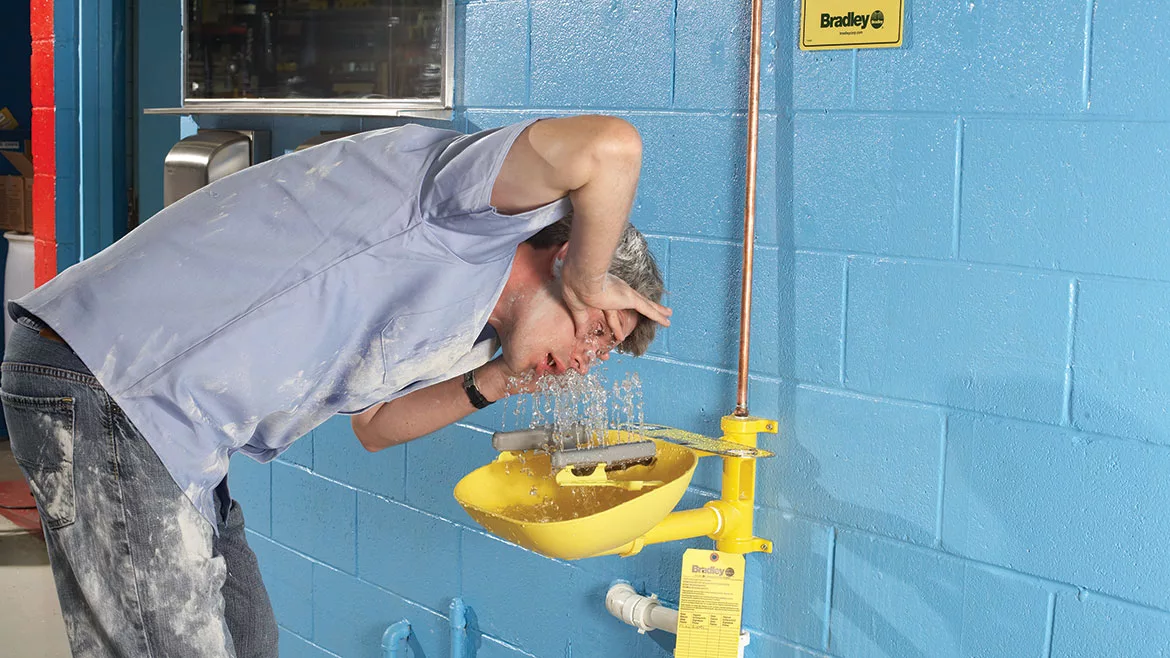
ANSI/ISEA Z358.1–2014 requires that tepid water be delivered to emergency fixtures, which encourages an injured party to complete the full 15-minute flush during an emergency. Image courtesy of Bradley Co.
Potential worksite hazards involving harmful chemicals, dusty conditions and flammable materials present serious risks for exposure and injury. In industrial settings, where hazardous materials are present, having reliable emergency eyewashes and safety showers ready for immediate use in case of exposure is critical. To be effective when needed, these systems must be designed, specified and installed in compliance with regulatory standards, ensuring they are maintained and able to perform immediately in the event of exposure.
Since plumbing engineers and contractors are tasked with specifying and installing emergency safety equipment, it is essential to understand best practices relative to their use and preparation. Following these approaches can help to minimize or abate injuries, prevent non-compliance and ensure efficient and safer operations for the facilities you design.
This article explores recommended practices in designing and specifying emergency eyewashes and safety showers, highlighting key compliance standards, installation tips and new technologies in the market.
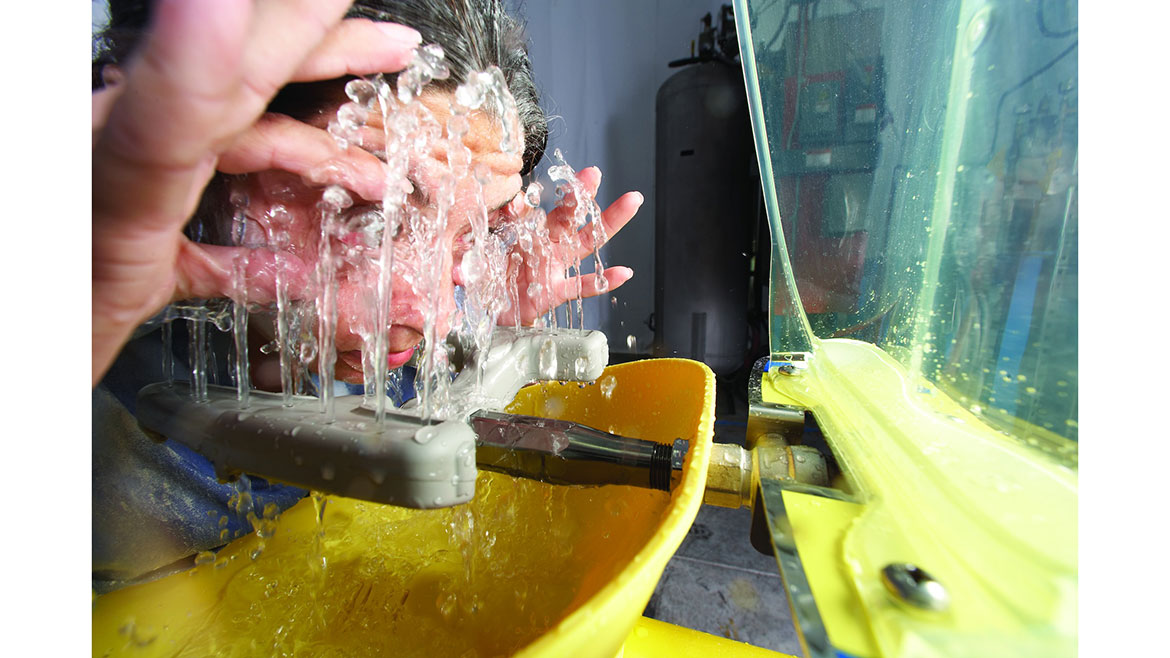
Image courtesy of Bradley Co.
1. Understanding compliance: OSHA and ANSI Standards
The Occupational Safety and Health Administration (OSHA) and the American National Standards Institute (ANSI) set clear guidelines for emergency eyewash and safety shower equipment. OSHA regulations require employers to provide proper emergency response equipment in any workplace where employees are exposed to harmful chemicals or materials. OSHA defers to ANSI/ISEA Z358.1–2014 American National Standard for Emergency Eyewash and Shower Equipment, which outlines the specific performance and installation criteria for eyewashes and showers.
ANSI Z358.1 cites key design and installation guidelines for plumbing engineers, such as:
- Flow Rates: Emergency showers must provide 20 gpm of water for at least 15 minutes, while eyewashes need to supply 0.4 gpm.
- Water Temperature: The water must be tepid to prevent further harm or thermal shock during flushing. Tepid water is defined as 60°-100° F or 16°-38° C. This temperature will need to be consistent throughout the entire 15-minute drench.
- Location: Units must be within 10 seconds (about 55 feet) of potential hazards, with clear, unobstructed access so the injured person can quickly and easily reach the plumbed fixture to immediately drench affected areas.
- Simultaneous Operation: In cases where multiple eyewashes or showers are installed, engineers must ensure the plumbing system can handle simultaneous usage without a significant drop in pressure or flow.
These standards are critical for protecting employees from chemical exposure and ensuring legal compliance for businesses. Understanding them from a plumbing perspective ensures that systems are properly designed, reducing the risk of OSHA fines and protecting employees.
Some product manufacturers offer complimentary safety shower and eyewash site surveys, which include a compliance review to the current ANSI/ISEA Z358.1 standard and provide operation and placement recommendations.
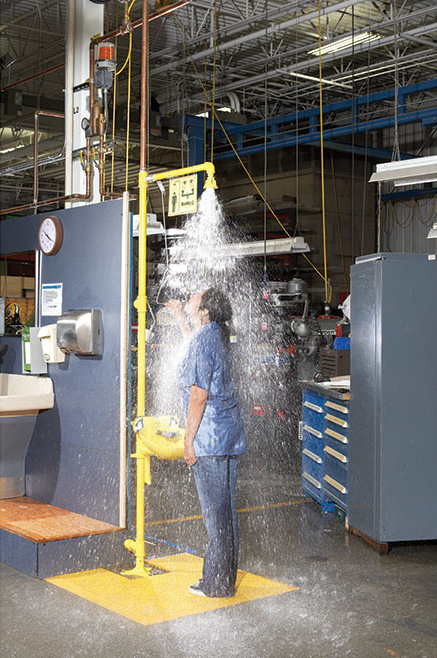
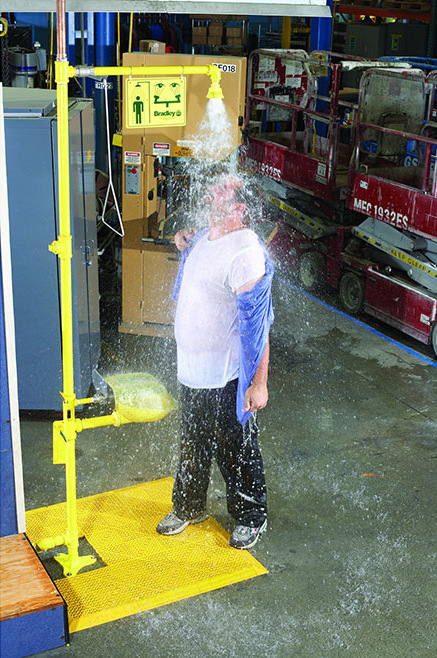
A drench shower, eyewash, or combination unit should be located within 10 seconds of a potential hazard or approximately 55 ft. (16.8 m) with unobstructed access. Image courtesy of Bradley Co.
2. Designing the system: Key considerations for plumbing engineers
For plumbing engineers, designing an emergency eyewash and shower system involves more than just meeting the minimum flow rates and temperatures. There are a variety of factors that impact system performance, maintenance and life cycle.
Water supply and pressure: Given that emergency showers require a significant flow of 20 gpm, it is essential to ensure the plumbing system is capable of delivering this without pressure drops. Engineers need to carefully size the pipes and water supply lines, particularly in large facilities where multiple stations may be activated simultaneously.
Hot and cold water blending: As mentioned earlier, it’s important to provide reliable on-demand tepid water for flushing fluid, which helps encourage a full 15-minute flush of the injured area. Water temperature control is also critical to avoid injuries from overly cold or hot water.
To address temperature fluctuations, both thermostatic mixing valves (TMVs) and electric tankless water heaters can deliver tepid water reliably and efficiently. TMVs are commonly used to blend hot and cold water automatically and ensure stable temperatures, even during fluctuations in supply temperature or pressure.
In environments where hot water supply is inconsistent or where temperature control is more challenging, tankless water heaters can efficiently deliver a consistent flow of tepid water for the 15-minute flush.
3. Installation tips: Placement considerations for plumbing contractors
The correct placement of emergency eyewash and safety shower stations is critical. Start with a site evaluation to identify at-risk areas, potential hazards and emergency needs, and evaluate factors like product location, water supply, water temperature, accessibility and equipment selection.
During a walk-through, it is essential to reference the ANSI/ISEA Z358.1–2014 emergency equipment standard, which outlines the specific requirements for emergency eyewash and drench shower equipment installation, testing, performance, maintenance, training and use. Safety data sheets (SDS) are another excellent source for determining protection needs, since they contain first aid information stating if drenching facilities are required.
As mentioned earlier, the ANSI/ISEA standard requires that such fixtures be installed within 10 seconds’ reach of each hazard, which is about 55 feet away. At sites where strong acids or caustics are used, the equipment should be placed immediately adjacent to where the exposure could occur. The equipment should be on the same level as the potential hazard.
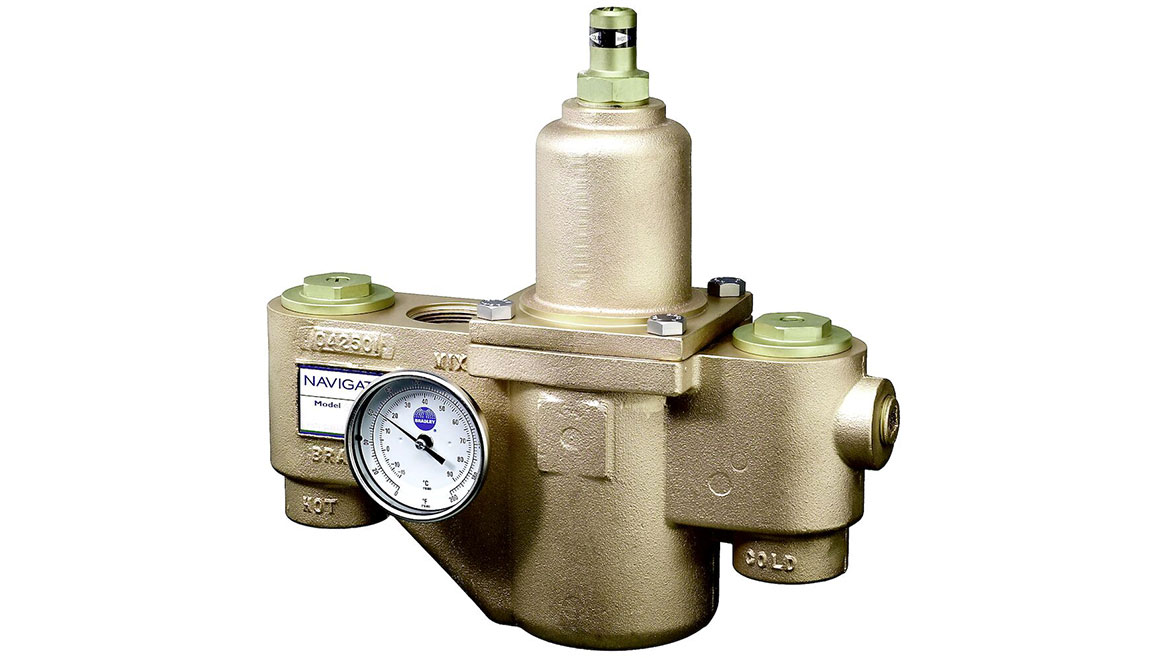
Thermostatic mixing valves (TMVs) are engineered to mix incoming hot and cold water to a tepid temperature of 65° F to 95° F (18° C to 35° C). Image courtesy of Bradley Co.
4. System maintenance and testing
Once installed, emergency eyewash and shower systems require regular testing and maintenance. To ensure they remain in working order equipment must be activated and rechecked every week, per ANSI/ISEA Z358.1.
During weekly inspections, it is important to check that plumbed emergency equipment works properly with no missing or broken parts and has lines flushed to clear debris and stagnant water. This activation ensures that nothing is blocking the flow of the flushing fluid and eliminates any chance of contamination from stagnant water. It’s important that all heads of the device are activated, including the eyewash or eye/face wash head, as well as the showerhead.
Take time to flush lines long enough to clear the line of sediment and debris. Self-contained units should also be visually inspected weekly. Inspection tags are often included with fixtures to document testing and to satisfy a safety audit. Keeping a dated checklist for inspections helps follow-through and accountability.
5. New product technology: Improving washdown coverage
Manufacturers are continuously looking for new ways to enhance eye wash station and shower technology, as well as systems for heating water commensurate with the ANSI/ISEA standard.
The newest generation of emergency fixtures is designed to deliver a more uniform and complete spray pattern distribution. Older shower designs push the flow of water to the outer rim of the showerhead, creating a hollow space in the center of the pattern that can miss affected areas.
Using the latest technology in fluid dynamics, new drench shower designs work in tandem with pressure-regulated flow control and the spinning motion of water, which creates an optimal spray pattern to rinse off contaminants as quickly and thoroughly as possible. The contoured shape combined with the spinning water funnels the water into a concentrated, yet gentle, deluge to ensure the most effective flush available.
New eye/face wash designs using this new technology can ensure water is dispersed to all areas of the face including the forehead, temples and chin. These new types of eye/face washes provide 20% better washdown protection than other designs.
In closing, designing and specifying emergency eyewash and safety shower systems is a critical responsibility for plumbing engineers and contractors. Following best practices can help protect workers from hazardous exposure and ensure facilities remain compliant with OSHA and ANSI standards. With the right design and technology, these systems can become integral, reliable components of workplace safety.
Looking for a reprint of this article?
From high-res PDFs to custom plaques, order your copy today!






